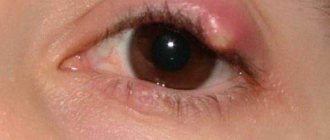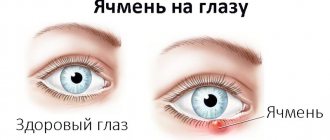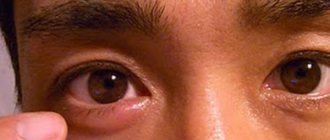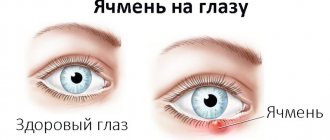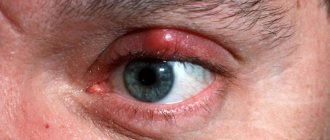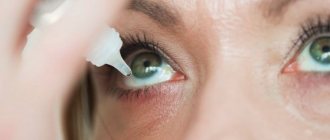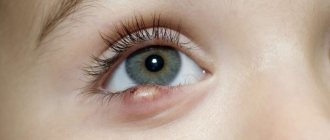What is barley?
In this article
- What is barley?
- What causes stye?
- What diseases provoke the development of hordeolum?
- Symptoms of stye
- Are blepharitis and stye the same thing?
- Why are blepharitis and hordeolum the same pathology?
Acute purulent inflammation of the hair follicle of the eyelashes or the sebaceous gland of Zeiss is barley. There are two forms of the disease: external and internal. The first type is more common. In this case, the inflammatory process covers the hair follicle or the sebaceous gland of Zeiss. The second form of pathology is less common. It occurs due to inflammation of the meibomian glands. The shape of the stye depends on where the inflammatory process occurs. The hair follicle and sebaceous gland of Zeiss are located on the outer part of the eyelid. If inflammation occurs in this area, ophthalmologists diagnose “external stye.” The Meibomian glands are located in one row in the thickness of the cartilaginous part of the upper and lower eyelids. If the inflammatory process occurs in this part of the eye, then they speak of the “internal form” of the pathology.
The name "barley" comes from its appearance. A ripe boil resembles a cereal grain. The medical name of the pathology sounds like hordeolum. This disease is considered the most common in ophthalmology. According to statistics, about 80% of the population suffers from it. Most often, the inflammatory process occurs in children. Adults aged 30-50 years are also susceptible to it.
What causes stye?
The reason why a stye forms on the eye is due to a bacterial infection. In most cases, inflammation begins due to the gram-positive bacterium Staphylococcus aureus. Getting it into the cavities of the sebaceous gland and ciliary sac may be due to non-compliance with hygiene rules. The main causes of the inflammatory process include:
- habit of rubbing your eyelids;
- eye irritation from wind, dust, smoke;
- use of low-quality cosmetics;
- allergic reactions;
- smoke in the air.
Less common are cases of the disease caused by the Demodex mite. It lives near hair follicles. Usually the presence of mites goes unnoticed. Many people learn about the presence of these parasites in the body only during the diagnosis of diseases. An increase in the number of ticks and the occurrence of an inflammatory process occurs with weakened immunity.
Ways to treat a pussy
Currently, there are effective drugs that accelerate and alleviate the course of the disease, preventing the occurrence of dangerous consequences.
Drug treatment
Prescribed at the initial stage of pussy maturation. To prevent the uncontrolled spread of pathogenic organisms, the affected area of the eyelid must be treated with disinfectant compounds. This should be done very carefully; some drugs can cause burns to the mucous membranes of the eyeball. After the pus leaves the abscess, it is recommended to treat open areas of the skin with the same medications.
Treatment of barley
Video: Why barley appears and how to cure it
Antibacterial therapy
To alleviate the course of the disease and localize the piss, doctors may prescribe antibacterial therapy. Special eye ointments and drops are used.
Table. Ointments and drops for the treatment of pussy.
| Antibacterial drops | Antibacterial ointments |
| Levomycetin. Prescribed during the treatment of conjunctivitis, keratitis and other diseases caused by microorganisms. Uncontrolled use is prohibited; breastfeeding should be stopped during the period of use. Drip three times a day, course of treatment is 5–15 days. | Tetracycline ointment. For external consumption only, avoid contact with mucous membranes of the eyes. The ointment has a pronounced pharmacological effect on pathogenic organisms. It is recommended to cover the eyes with a clean cloth after application. Course up to three weeks. |
| Phloxal. The active substance is ofloxacin, an antimicrobial agent. Before prescribing, the body’s tolerance should be checked; the dose is always prescribed by the doctor depending on the stage of the disease and the age of the patient. The duration of use should not exceed two weeks. | Hydrocortisone ointment. Not for pregnant and breastfeeding mothers. For local use, it effectively relieves swelling, eliminates itching, and localizes inflammatory processes. Treatment should be carried out under constant medical supervision. |
| Tsipromed. Antimicrobial eye drops are used for inflammatory processes. The frequency of use is adjusted taking into account the course of the disease. In difficult cases, up to 12 drops per day are prescribed. Has no side effects. |
Treatment of stye on the eye
The effectiveness of ointments is higher; they stay on the affected area of the eyelid longer. Drops and ointments should be warmed to room temperature before use. When a puss appears, you should not cover it with cosmetics.
Maintenance therapy
Used as an additional measure to increase the body's resistance. Protective functions are improved by consuming vitamins C and A; in some cases, additional intake of complex vitamin preparations is prescribed. At high temperatures, you can use paracetamol.
Vitamin A
Video: Stye on the eye. How to treat?
Surgical treatment
Surgical methods for treating piss are rarely used and only in extreme cases when other methods have proven ineffective. The abscess does not open on its own for a long time, a chalazion develops, and a large seal begins to mechanically irritate the eyeball.
The abscess is punctured or a small incision is made on it. Subsequently, the doctor drains the fluid and treats the wound with antibacterial ointment. There are cases when there are indications for complete removal of the tumor.
Surgical removal of chalazion
To speed up the maturation of the pussy, the doctor may prescribe UHF therapy. The high-frequency electromagnetic field affects only the affected tissues and inhibits the proliferation of microorganisms.
What diseases provoke the development of hordeolum?
It is believed that the main cause of barley is hypothermia and associated colds. The inflammatory process often develops due to weakened immunity, which cannot fight bacteria and viruses. Pathologies of a bacterial and viral nature that cause inflammation include diseases such as:
- sinusitis;
- ethmoiditis;
- tonsillitis;
- sphenoiditis;
- frontitis.
Stye is one of the common consequences of many chronic diseases. They not only lead to inflammation, but also complicate its diagnosis and treatment. In some diseases, it is very difficult to get rid of barley forever, as they predispose to relapses of the inflammatory process. Such pathologies include:
- anemia;
- gastritis;
- diabetes;
- stomach ulcer;
- hyperlipidemia;
- peritonitis;
- furunculosis.
The body must regularly receive the amount of vitamins required for its normal functioning. The development of the inflammatory process is often associated with a deficiency of vitamins A, B and C.
Sometimes stye occurs due to disorders that many people think do not pose a health risk. For example: helminthiasis, skin tendency to become greasy, acne formation.
When is the best time to get tested as part of the examination?
Many people are interested in whether it is necessary to be examined immediately after discharge from the hospital (or completion of a course of home treatment) or should a certain period of time pass? Here again, you should follow the recommendations of your doctor.
With the help of studies, it is possible to confirm the final recovery, evaluate at the end of the disease how well the recovery process is going, and also eliminate the risks of complications after an infection. The period when a client is recommended to undergo this complex depends on the goals of the study.
Symptoms of stye
The inflammatory process usually develops quite quickly. Stye is not a condition that can remain asymptomatic for a long time.
From the first days, inflammation is accompanied by swelling of the eyelids, burning and itching. For some people, blinking becomes more rapid. In severe cases, very severe swelling occurs at the site of the hordeolum, which makes it difficult for a person to open his eyes in the morning. The main signs of barley are:
- redness and swelling of the eyelids;
- sticking and loss of eyelashes;
- sensation of a foreign body in the eye;
- thickening of the edges of the eyelids;
- photosensitivity.
Some people develop a fever during hordeolum formation. They get tired quickly, feel unwell and weak. When pressing on the lesion, painful sensations occur. The initial stages of inflammation are often accompanied by headache and pressure in the temples. In severe forms of stye, which occur during ARVI or against the background of conjunctivitis, foamy contents may accumulate in the corners of the eyes.
Are blepharitis and stye the same thing?
The causes and symptoms of stye formation are very similar to the signs and factors for the development of blepharitis. Because of this, many people believe that these are the same disease. Blepharitis is a bilateral inflammation of the ciliary margin of the eyelids, which can recur. Its occurrence may be preceded by various reasons, so doctors distinguish several forms of this pathology, namely:
- acne;
- seborrheic;
- allergic;
- demodicosis;
- ulcerative
In ophthalmology, the term "blepharitis" is often used to refer to a large group of inflammatory diseases. All of them form on the eyelids and often reappear after treatment. The most common conditions that ophthalmologists can characterize as blepharitis are: stye, meibomitis, chalazion. These pathologies sometimes develop in turn. In the absence of proper treatment, one inflammatory process flows into another. The "internal form" of the hordeolum is a meibomite. The condition is associated with inflammation of the meibomian glands. There is also a meibomian type of blepharitis, which is similar in symptoms and course to the “internal form” of stye. One of the signs of hordeolum is thickening of the edges of the eyelids and the formation of dry scales at the site of inflammation. Barley, which is characterized by this symptom, resembles seborrhea of the eyelids - scaly blepharitis.
Why are blepharitis and hordeolum the same pathology?
It is very simple to understand that blepharitis and stye are different names for the same condition. To do this, you need to understand how the inflammatory process occurs, what symptoms are characteristic of it and what factors precede its formation. The causes of inflammation of blepharitis and stye are:
- chronic diseases;
- hypothermia of the body;
- increased production and blockage of sebaceous glands;
- entry into the body of bacteria, viruses, fungi;
- reduced immunity.
The inflammatory process always forms at the edge of the eyelid, near the ciliary bulb. From the first days it takes an acute course. The main symptoms of gordeolum and blepharitis: itching, burning, swelling of the eyelids. A few days after its appearance, the focus of inflammation turns into an abscess, which soon bursts. Treatment of blepharitis and stye is conservative. It is recommended to treat the affected skin with 70% ethyl alcohol, iodine solution or brilliant green. Penicillin or sulfacyl ointment is applied over the source of inflammation. A solution of sulfacetamide is instilled into the conjunctival cavity.
An effective method is to combine medication and physiotherapy. Ophthalmologists prescribe electrophoresis sessions, treatment with UV rays, quartz tubes, and ultra-high-frequency therapy. Symptoms and signs of stye and blepharitis are the same, treatment is similar. From this we can conclude that these diagnoses correspond to the same condition.
Don't spit on your eyelid
The widespread prevalence of this disease has led to the emergence of many “folk” methods of treatment. But don’t delude yourself - staphylococcus is not afraid of saliva, urine, or tea infusion.
The correct tactics when barley appears is as follows. You should immediately abandon any cosmetic procedures and not apply makeup to your eyes. At the very beginning of the disease, local cauterization with 70% alcohol or a solution of brilliant green helps. Albucid is instilled into the eye or tetracycline or erythromycin ointment is applied.
Article on the topic
Be careful, drafts! The first signs of the disease and methods of treatment
The most important thing: the stye should not be squeezed out, since the purulent contents can spread to the eyelid, and this is fraught with an abscess, phlegmon of the eyelid and other serious complications. If it doesn't get better within a day, you should consult a doctor.
Stye is usually easy to treat, but if it does not heal for a long time, you should be wary. Some other diseases, such as a cyst, can be “masked” under the guise of barley.
